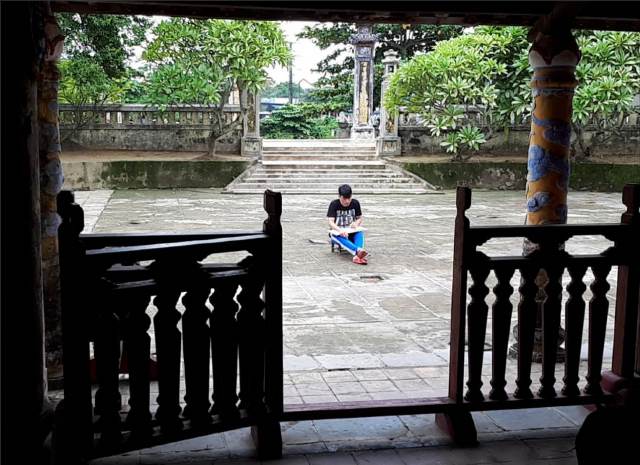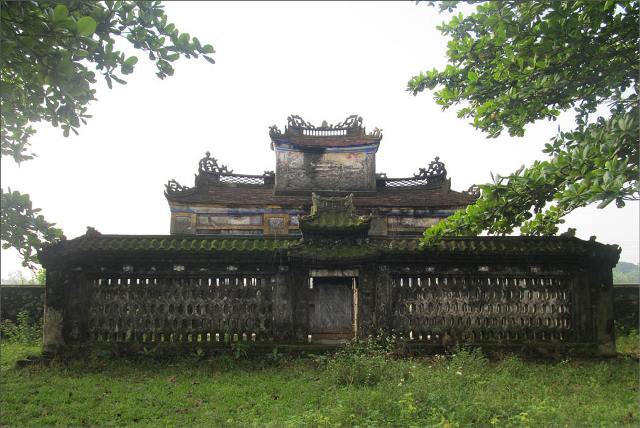
Field survey. Photo: Dac Thai
Region of heritage
The globalization tendency and the flat world have brought people from everywhere closer to one another and erased all boundaries and differences. However there appears the need of returning to the origin to emphasize the identities which create typical differences. It is the core of The Journey to the Past - a cooperation program between Vietnam National Institute of Culture and Arts Studies in Hue and the Faculty of Fine Arts at Van Lang University in Ho Chi Minh City beginning in 2016.
Hue in particular and the Central area in general is the region that nurtures layers of sediments of native cultural heritage, combined with the cultures of the North and the South. As the headquarters of Cochinchina, then the imperial capital in the Nguyen Dynasty’s era, Hue is the place where the cultural elite of the whole country converge. It is also the land of meditation and the center of Buddhism. They all can be seen through many aspects: customs, religious beliefs, ways of living and thinking, architecture, sculpture, fine arts, etc.
It is because of such prominent typical values of a region of cultural heritage that we decide to access Hue as a living museum, a realistic environment for researching, training, and applying the traditional fine art values in present-day life.
Accessing
In 2004-2005, some results gained from field surveys far and wide suggested the direction to access the ancient fine art heritage in the Central area that later gave rise to the publication of the books Fine Arts in the Nguyen Lords’ Times: From the Royal Tomb Heritage (Nguyen Huu Thong; editor-in-chief, Hue, Thuan Hoa Publishing House, 2014) and Hindu Statues for Worship: From Cham Towers to Vietnamese Pagodas and Temples (Nguyen Huu Thong; editor-in-chief, Hue, Thuan Hoa Publishing House, 2016). On that basis, there has appeared an urgent need to cooperate and develop the strengths in studying and teaching fine arts and the history of culture between the Institute and Van Lang University.
In that context, the traditional cultural heritage in the Central region, especially Thuan Hoa - Phu Xuan - Hue is even urgently noticed. The aim is to access it fully to make surveys, collect, measure, film and take photos, etc., from which a set of data about the traditional fine art heritage of Hue will be built step by step carefully with the utmost assistance of modern digital means.
After that, the collected data will be sorted and processed to become scientific documents about traditional fine arts. These crucial data will serve as a realistic and useful tool for researching and teaching, especially about applied fine arts. All of the above aim to apply harmoniously, properly and effectively Vietnamese traditional modules and motifs (abundant in Hue) to consumer products.

Surveying Van Xa Communal House. Photo: Dinh Hung
The Journey to the Past has so far concentrated on surveying, collecting data and exploiting the values of traditional fine arts in the complex of architectural monuments of the Nguyen Dynasty (the constructions in the Citadel, the Royal Tombs), the architectural and fine art heritage of traditional communal houses in Thua Thien-Hue, the heritage of nha ruong and garden houses in Hue, the heritage of visual art in textile and Zeng products by Ta Oi in A Luoi district, etc.
Initial results
In the cooperation and exchange content in researching and teaching, besides researchers of the Institute in Hue going to work in Ho Chi Minh City, every year Van Lang University organizes 1to 3 surveys on Hue traditional fine art heritage, with the participation of more than 150 lecturers and students. Scientific and training activities in a practical way have so far proved useful and interesting to participants, bringing them to Hue traditional fine art heritage. They, the participants, will in turn spread their influence in life and to modern products.
The results of field surveys will be digitized in a scientific way, becoming practice/graduation reports and being displayed in exhibitions and theme workshops. On a higher level, they will serve as realistic documents for the writing of teaching materials or researches on fine arts such as Screens in Hue Cultural Life, Decorative Art at Traditional Communal Houses in Hue, Decorative Art at Traditional Garden Houses in Hue, (Ta Oi) Zeng Decorative Patterns of Ta Oi people in A Luoi, etc.
An effective and realistic way to conserve and promote the value of Hue traditional cultural heritage is to bring people to the heritage, since then, to convey and bring the best of the traditional heritage into the products. Hue in particular and the Central region in general is really a living museum, a practical land for researching and training about fine arts, historical matters and traditional culture.
Story: TRAN DINH HANG